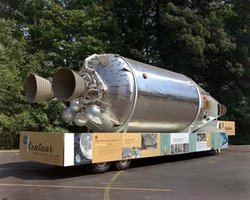Centaur (rocket stage)
|
|
The Centaur is an upper stage rocket designed for use on satellite launch vehicles, boosting the satellite into its final orbit or, in the case of interplanetary probes, to escape velocity.
Centaur, named after the centaurs of Greek mythology, was the brain child of Karel J. "Charlie" Bossart (the man behind the Atlas ICBM) and Dr. Krafft A. Ehriche, both Convair employees. Development started in 1956, but proceeded slowly, with the first (unsuccessful) test flight in May 1962. The first successful flight was some 3 years later. In the late 1950's and early 1960's Centaur was proposed as a high energy upper stage for the Saturn I, Saturn IB and Saturn V rockets.
Centaur was the world's first high-energy upper stage. It burns liquid hydrogen (LH2) and liquid oxygen (LOX), stored in balloon tanks, in either one or two RL-10 cryogenic rocket engines.
Centaur uses an ingenious common double-bulkhead to separate the LOX and LH2 tanks. The two stainless steel skins are separated by a 0.25 inch (6.4 mm) layer of fiberglass. The extreme cold of the LH2 on one side creates a vacuum within the fiberglass layer, giving the bulkhead a low thermal conductivity, and thus preventing heat transfer from the reasonably warm LOX to the super cold LH2.
A version of the Centaur was developed for use with the Space Shuttle but was never used due to tougher safety rules imposed after the Challenger accident. This decision helped lead the US Air Force to create the Titan IV, which uses the Centaur as its final stage, to launch payloads which had originally been designed for the Shuttle-Centaur combination.
As of 2004, Centaur is in regular use on Atlas-Centaur and Titan-Centaur launch vehicles.
Links
- Centaur versions and launch list (http://skyrocket.de/space/doc_stage/centaur.htm)de:Centaur (Rakete)

